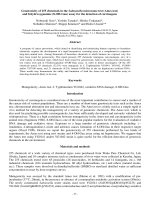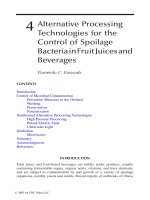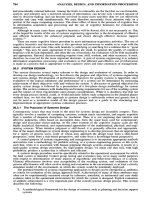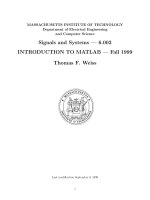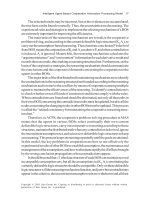greenhouses. mist propagation systems and humidity chambers for the nursery and greenhouse
Bạn đang xem bản rút gọn của tài liệu. Xem và tải ngay bản đầy đủ của tài liệu tại đây (1.33 MB, 6 trang )
Division of Agricultural Sciences and Natural Resources • Oklahoma State University
F-6708
Oklahoma Cooperative Extension Fact Sheets
are also available on our website at:
Michael A. Schnelle
Associate Professor Extension
Ornamentals/Floriculture Specialist
Janet C. Cole
Associate Professor
Omamental Horticulture
John M. Dole
Associate Professor
Floriculture
Misting is a technique for minimizing plant moisture loss by
controlled periodic wetting of the foliage of cuttings which are
being rooted. This technique is helpful for rooting leafy cuttings;
however, succulent plants are usually not placed under mist.
Constant misting has been successful with a few plants, but
results are generally better with intermittent misting. Constant
misting wastes water, leaches nutrients from the leaves, and
reduces soil temperatures which, consequently, restricts root
development. Mist beds can be used in greenhouses year
round or during the growing season for nursery stock.
The on-off interval for misting depends upon how quickly
water dries from the leaves. Ideally, the mist should be turned
on just after the leaves become dry and should remain on long
enough to wet all leaf surfaces. Cuttings quickly die if they
become dry and are exposed to bright sunlight for even a short
period; therefore, it is important that the leaves be kept wet
at all times when the sun is shining on them. Over-misting is
generally considered less detrimental than over-watering.
Before mist propagation became widely accepted, rooting
was attempted by maintaining high relative humidities in the
rooting area and restricting sunlight by partial shading when
sunlight became intense. The use of partial shading, however,
reduces the rate of photosynthesis which indirectly restricts
the rate of root development. This, obviously, is undesirable.
However, various degrees of shading may be appropriate
depending upon the species, location, and time of year.
Misting reduces leaf transpiration in two ways. First, it
causes a reduction in leaf temperature due to evaporative cool-
ing as the water on the leaf evaporates. Second, it maintains
high humidity conditions at the leaf surface. The cooling is
reported to be as much as 1°F to 1.5°F as compared to leaves
not misted. These cooling effects are effective, however, it is
recommended that mist propagation beds be shaded when
necessary.
The development of disease under mist may be a serious
problem. Botrytis and bacterial soft rots can be major problems
with leafy cuttings, particularly if sanitary conditions are not
maintained.
Algae can become a problem in areas which remain wet
most of the time. If algae does cause a problem, chemicals
injected through the water system can be used for control.
Mist Propagation Bench
Mist propagation is most commonly achieved by adapt-
ing a bench for the propagation area (Figure 1) or by using
a ground bed. Since the area will be kept wet constantly, the
bottom and sides should be of a material that is highly resistant
to water. Construct the bench of stainless steel wire and metal
frames to provide proper air circulation. The bottom can be
covered to a depth of 1-inch with a freely draining material
such as gravel or crushed stone. The size of the aggregate
should be about 1/4-inch. The gravel should then be covered
with 2 to 3 inches of sand.
If flats are used for holding the rooted cuttings, the flats
can be placed directly on the bench top or on sand. If the
cuttings are to be rooted directly in the bench, the rooting
medium (for example, a mixture of 3 parts sand and 1 part
peat) should be placed to a depth of about 2 inches on top of
the sand. Since the mist tends to lower soil temperature, which
restricts root development, best results are obtained when the
soil medium is warmed. For most plants, a temperature of
75°F is considered optimum. To achieve such temperatures,
electric heating cable can be placed on the bench or slightly
above the gravel layer in the sand. Standard soil electric
heating cable units are available in lengths of 30, 60, and
120 feet. Thermostat controls are also available that permit
raising the soil temperature to whatever level is desired for
the specific plant species being rooted. Many growers place
flats of cuttings or seeds directly on the bench. This practice
allows for greater sanitation since flats can be easily moved
and the benches cleaned.
When the greenhouse is heated with steam or hot water,
some soil warming can also be provided by placing one or
more heating pipes below the bench. If this arrangement
is used, the piping below the bench should be separately
controlled so that heat can be added even when greenhouse
space heating is not required.
Other features of benches such as required supporting
framework, bench dimensions, and construction features are
Mist Propagation Systems
and Humidity Chambers
for the Nursery and Greenhouse
Oklahoma Cooperative Extension Service
6708-2
discussed in detail in Extension fact sheet F-6703, “Green-
house Floors and Benches.” Mist benches are often placed
in inexpensive polyethylene Quonsets in nurseries for added
protection to the propagation area. Refer to Extension fact
sheet F-6700 “Greenhouse Structures and Coverings” for
additional information.
Piping Arrangement
The mist nozzles are normally placed on the end of a
vertical riser from a distribution pipe placed on or below the
propagating bed. Such an arrangement avoids dripping from
the nozzles when the water is turned off, and the riser does not
interfere with the uniformity of the mist pattern. If the nozzles
are placed on a pipe running above the bed, the nozzles
should preferably be placed on the bottom of the pipe so that
droplet collection on the distribution pipe is minimal. Dripping
from the nozzles is still a problem with this arrangement due
to water draining from the pipe when the water is turned off.
The distribution pipe size depends upon the water dis
-
charged by the nozzles and the number of nozzles installed
along the length of the pipe. Most mist nozzles discharge
from 4 to 15 gallons of water per hour (gph). A 1-inch line will
distribute water to 50 of the higher 15 gph capacity nozzles
without significant pressure loss, a 3/4-inch line to 25 nozzles,
and a 1/2-inch line to 8 nozzles. Approximately four times as
many of the 4 gallon-per-minute nozzles could be placed on
each of these lines. To minimize dripping, be certain that the
mist lines are straight and level.
The risers should normally be made of 1/2-inch diameter
pipe. Depending upon nozzle type, the nozzles require a
minimum water pressure of 20 to 40 pounds per square inch
(psi) for effective distribution over the bed. Pressures as high
as 120 psi can be used with some mist nozzles. If the water
main pressure in the greenhouse is below the required pres-
sure, a booster pump should be placed in the water line to
obtain the required pressure.
Since all of the nozzles have rather small orifices and
openings, a filter or strainer should be placed in the line to
remove solids that could plug the nozzles.
The control valve is generally an electrically operated
solenoid valve that turns the water on and off in response to
a control signal.
Whirling nozzles use small slots within the internal body
of the nozzle to break up the water and to generate small
droplets which then pass through an orifice and outward away
from the nozzle. Since the slots are small, these nozzles are
particularly susceptible to plugging. The whirling nozzles are
specifically made for mist-propagation discharge of the water
from an angle of 160 degrees. They are recommended for
use at pressures from 35 to 100 psi.
The deflection-type nozzles have larger orifices than
the whirling nozzles and, therefore, have less of a tendency
to be plugged by solid particles in the water. Since they are
simpler in construction, they are also generally a little less
expensive than the whirling nozzles. The uniformity of water
distribution over the bed area with deflection nozzles is quite
Figure 1. Layout for typical mist bench
Setup appropriate for direct use on the ground as well
variable and for a given nozzle could either improve or be-
come worse as the pressure increases. You can check the
uniformity of distribution by placing water cups over the bed
area and observing the water collected after a given period of
operation. The gap between the face of the orifice and deflec-
tion plate, and the centering of the plate over the orifice can
be adjusted for most deflection-type nozzles. Adjustment is
recommended whenever uniformity of distribution differs by
more than 50 percent. The output of the deflection nozzles is
generally higher than the whirling nozzles, varying between
4 and 15 gallons per hour for the nozzles tested.
Nozzle Position
The nozzle should be spaced so that there are no dry
areas on the bed and so the overlap is minimal. If excessive
overlap occurs, excessive wetting may result. Most nozzle
manufacturers recommend the nozzle spacing which they
feel provides the best results. The most common recom-
mended spacing is 3 to 4 feet. Be sure to follow the particular
manufacturer’s advice.
Nozzles are normally placed about 18 inches above
the plant-bed surface. Some manufacturers may, however,
recommend lower heights.
Controls for Misting Systems
Most mist propagation systems are controlled with two
time clocks. The first is a 24-hour clock which turns the system
on during the daylight hours and off at night. The second is a
cycle timer which controls the duration of the “on” cycle and
the interval between mist cycles. The clock should allow both
of these intervals to be adjusted to correspond to the growing
and environmental requirements. During bright, warm, summer
days in Oklahoma, the optimum number of mist cycles can be
as many as 20 per hour. Each “on” period should be as short
as possible but long enough to fully wet all leaf surfaces.
A number of greenhouse equipment suppliers provide
time clocks with the capability to provide such adjustments
(see suppliers listed on back page).
The disadvantage of clock-type controls is that they must
be set for bright sunlight conditions so that the plants do not
become dry during periods of maximum stress. When set in
such a manner, they over-water whenever the sun is less
intense, when clouds reduce the solar radiation entering the
house, or when the drying rate is reduced due to a reduction
in air temperature. For this reason, several different types of
automatic controls have been developed. One is a pivoting
beam (Mist-a-matic) that has a piece of screen on one end of
the beam and a movable counterweight on the other. The unit
is placed under the misted area where water collects on the
screen. The additional weight overcomes the counterbalance
causing the beam to move down. A switch connected to the
beam then shuts the water off. When the misting stops, the
water on the screen dries which reduces the weight on that
end of the beam. When adequate water has evaporated, the
beam rotates in the opposite direction activating the switch
and turning the mist back on. By adjusting the position of the
counterbalance weight, the drying interval and mist time can
be controlled within reasonable limits.
In a second type of control system (electronic leaf) the
water completes an electric circuit between two electrodes,
Types of Mist Propagation Nozzles
Two basic types of nozzles are used in mist propagation
systems:
1. Oil-burner nozzles, which have a whirling action.
6708-3
2. Deflection nozzles, which employ a small stream of water
impacting against a small, flat plate.
activating a control circuit. This system does not involve any
moving parts and is not as subject to variation due to wind,
insects, or dirt accumulation and pivot friction. Salt accumula-
tion is a problem with the electronic leaf as well as the Mist-
a-matic. Both require periodic cleaning with the frequency
contingent upon the water source.
Regardless of the type of control used, it should permit
a gradual reduction in the frequency of misting as plants
become rooted. Such control enables the grower to harden
the plants to the water stresses involved with normal watering
practices before cuttings are removed from the mist propaga-
tion area.
Since even short periods of dryness with new cuttings can
be fatal, over-wetting is not considered to be as detrimental as
under-wetting. For this reason, the solenoid valve used in the
water distribution line should be one which is normally open
(that is, open when no current is provided to the control). If
an electric power failure occurs, the mist will operate continu-
ously, keeping the plants wet throughout the electric power
failure. This is, of course, dependent upon having a water
supply system which maintains line pressure during periods
of electrical power failure.
Humidity Chambers
Humidity chambers provide an alternative to automated
mist systems. These systems have proven successful in
major United States’ greenhouse operations as well as being
popular abroad. A humidity chamber wilI aid in rooting and/or
germination of many species. The success rate is comparable
or possibly superior to mist systems under certain conditions
(Figures 2a and 2b).
Summary
Mist propagation of plant cuttings is a widely accepted
practice. For best results, the mist should be operated intermit-
tently. The on-off interval for misting should keep all cuttings
constantly wet. The propagation area is generally placed on
a bench for convenience. It may, however, be placed directly
on the ground in a nursery setting for example.
Ideally, the total propagating area should be uniformly
moistened. In practice, this is difficult to achieve due to various
nozzle characteristics. However, extreme variations in water
distribution should be avoided. Both whirling and deflection-
type nozzles can give good results when operated at water
pressures between 25 and 60 psi on 4-foot wide benches.
For deflection-type nozzles, obtaining the best uniformity of
water distribution may require adjustments of the gap between
the deflection plate and nozzle orifice, and the position of the
plate over the orifice. Periodically check nozzles for plugged
orifices.
Some form of automatic control is essential to prevent
excessive use of water and detrimental growth effects due to
over-watering which occurs with continuous misting. Since as
many as 20 on-off cycles may be necessary per hour, manual
control is impractical. The most common control is the electric
time clock; however, devices which sense and actuate as a
result of the drying rate would be preferable. Two such devices
are available: a counterbalanced rotating beam with a switch
and an electronic artificial leaf where wetting completes an
electronic circuit. Lastly, despite the ideal environment a mist
bench system provides, rooting powder or quick dip hormone
solutions may be necessary for species that are difficult to
root.
Hardening-off Cuttings
Tender cuttings will be shocked if not carefully removed from a
moist, humid environment to a dryer setting. Below are steps
considered to ease this transition:
1. Gradually decrease misting periods.
2. Some nurseries allow cuttings to root into the soil be
-
neath the rooting medium. The mist frame is removed
altogether.
3. Root cuttings in small containers arranged in flats under
mist. Plants can then be transplanted with little stress.
Block-type rooting mediums are routinely used such as
oasis cubes and rockwool cubes.
4. Pot up cuttings and move them to a shaded, humid
location, gradually increasing sunlight and decreasing
watering intervals.
WARNING: Consult a competent electrician for the electri-
cal installation of the mist system. Due to the presence of
water, the potential for electrocution from an improperly
installed system is high.
Hardware Suppliers
American Plant Products and Services, Inc.
9200 Northwest 10th Street
Oklahoma City, OK 73127
(405) 787-4833
Aqua-Hort Systems, Inc.
P.O. Box 57197
Oklahoma City, OK 73157
(405) 521 -8002
6708-5
6708-4
Figure 2a.
Figure 2b.
activating a control circuit. This system does not involve any
moving parts and is not as subject to variation due to wind,
insects, or dirt accumulation and pivot friction. Salt accumula-
tion is a problem with the electronic leaf as well as the Mist-
a-matic. Both require periodic cleaning with the frequency
contingent upon the water source.
Regardless of the type of control used, it should permit
a gradual reduction in the frequency of misting as plants
become rooted. Such control enables the grower to harden
the plants to the water stresses involved with normal watering
practices before cuttings are removed from the mist propaga-
tion area.
Since even short periods of dryness with new cuttings can
be fatal, over-wetting is not considered to be as detrimental as
under-wetting. For this reason, the solenoid valve used in the
water distribution line should be one which is normally open
(that is, open when no current is provided to the control). If
an electric power failure occurs, the mist will operate continu-
ously, keeping the plants wet throughout the electric power
failure. This is, of course, dependent upon having a water
supply system which maintains line pressure during periods
of electrical power failure.
Humidity Chambers
Humidity chambers provide an alternative to automated
mist systems. These systems have proven successful in
major United States’ greenhouse operations as well as being
popular abroad. A humidity chamber wilI aid in rooting and/or
germination of many species. The success rate is comparable
or possibly superior to mist systems under certain conditions
(Figures 2a and 2b).
Summary
Mist propagation of plant cuttings is a widely accepted
practice. For best results, the mist should be operated intermit-
tently. The on-off interval for misting should keep all cuttings
constantly wet. The propagation area is generally placed on
a bench for convenience. It may, however, be placed directly
on the ground in a nursery setting for example.
Ideally, the total propagating area should be uniformly
moistened. In practice, this is difficult to achieve due to various
nozzle characteristics. However, extreme variations in water
distribution should be avoided. Both whirling and deflection-
type nozzles can give good results when operated at water
pressures between 25 and 60 psi on 4-foot wide benches.
For deflection-type nozzles, obtaining the best uniformity of
water distribution may require adjustments of the gap between
the deflection plate and nozzle orifice, and the position of the
plate over the orifice. Periodically check nozzles for plugged
orifices.
Some form of automatic control is essential to prevent
excessive use of water and detrimental growth effects due to
over-watering which occurs with continuous misting. Since as
many as 20 on-off cycles may be necessary per hour, manual
control is impractical. The most common control is the electric
time clock; however, devices which sense and actuate as a
result of the drying rate would be preferable. Two such devices
are available: a counterbalanced rotating beam with a switch
and an electronic artificial leaf where wetting completes an
electronic circuit. Lastly, despite the ideal environment a mist
bench system provides, rooting powder or quick dip hormone
solutions may be necessary for species that are difficult to
root.
Hardening-off Cuttings
Tender cuttings will be shocked if not carefully removed from a
moist, humid environment to a dryer setting. Below are steps
considered to ease this transition:
1. Gradually decrease misting periods.
2. Some nurseries allow cuttings to root into the soil be
-
neath the rooting medium. The mist frame is removed
altogether.
3. Root cuttings in small containers arranged in flats under
mist. Plants can then be transplanted with little stress.
Block-type rooting mediums are routinely used such as
oasis cubes and rockwool cubes.
4. Pot up cuttings and move them to a shaded, humid
location, gradually increasing sunlight and decreasing
watering intervals.
WARNING: Consult a competent electrician for the electri-
cal installation of the mist system. Due to the presence of
water, the potential for electrocution from an improperly
installed system is high.
Hardware Suppliers
American Plant Products and Services, Inc.
9200 Northwest 10th Street
Oklahoma City, OK 73127
(405) 787-4833
Aqua-Hort Systems, Inc.
P.O. Box 57197
Oklahoma City, OK 73157
(405) 521 -8002
6708-5
6708-4
Figure 2a.
Figure 2b.
6708-6
The Oklahoma Cooperative Extension Service
Bringing the University to You!
• It provides practical, problem-oriented education
for people of all ages. It is designated to take
the knowledge of the university to those persons
who do not or cannot participate in the formal
classroom instruction of the university.
• It utilizes research from university, government,
and other sources to help people make their own
decisions.
• More than a million volunteers help multiply the
impact of the Extension professional staff.
• It dispenses no funds to the public.
• It is not a regulatory agency, but it does inform
people of regulations and of their options in meet-
ing them.
• Local programs are developed and carried out in
full recognition of national problems and goals.
• The Extension staff educates people through
personal contacts, meetings, demonstrations,
and the mass media.
• Extension has the built-in flexibility to adjust its
programs and subject matter to meet new needs.
Activities shift from year to year as citizen groups
and Extension workers close to the problems
advise changes.
The Cooperative Extension Service is the largest,
most successful informal educational organization
in the world. It is a nationwide system funded and
guided by a partnership of federal, state, and local
governments that delivers information to help people
help themselves through the land-grant university
system.
Extension carries out programs in the broad catego-
ries of agriculture, natural resources and environment;
family and consumer sciences; 4-H and other youth;
and community resource development. Extension
staff members live and work among the people they
serve to help stimulate and educate Americans to
plan ahead and cope with their problems.
Some characteristics of the Cooperative Extension
system are:
• The federal, state, and local governments
cooperatively share in its financial support and
program direction.
• It is administered by the land-grant university as
designated by the state legislature through an
Extension director.
• Extension programs are nonpolitical, objective,
and research-based information.
The Cooperative Extension Service does not endorse any of the companies or products referred to herein. Names given merely
represent commonly available sources for these type products.
Oklahoma State University, in compliance with Title VI and VII of the Civil Rights Act of 1964, Executive Order 11246 as amended, Title IX of the Education Amendments of 1972, Americans
with Disabilities Act of 1990, and other federal laws and regulations, does not discriminate on the basis of race, color, national origin, gender, age, religion, disability, or status as a veteran in
any of its policies, practices, or procedures. This includes but is not limited to admissions, employment, financial aid, and educational services.
Issued in furtherance of Cooperative Extension work, acts of May 8 and June 30, 1914, in cooperation with the U.S. Department of Agriculture, Robert E. Whitson, Director of Cooperative Ex-
tension Service, Oklahoma State University, Stillwater, Oklahoma. This publication is printed and issued by Oklahoma State University as authorized by the Vice President, Dean, and Director
of the Division of Agricultural Sciences and Natural Resources and has been prepared and distributed at a cost of 42 cents per copy. 0803
